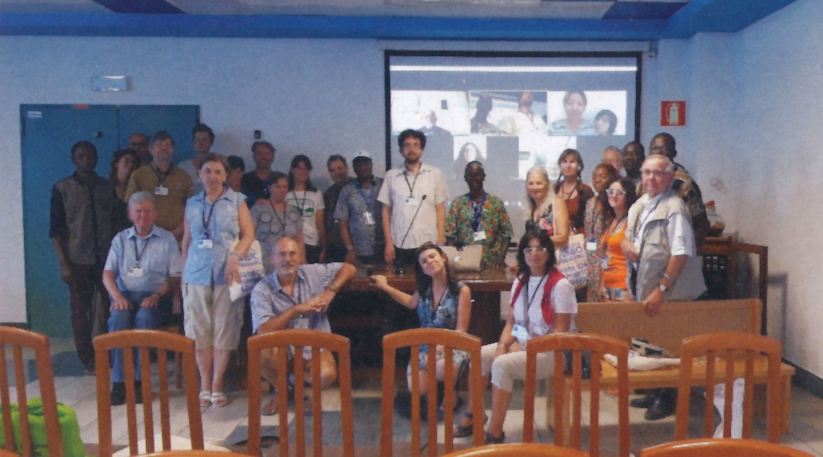
A Seminar on “Intercultural Competence”, Lignano Sabbiadoro, Italy, 2023
Participants attended “ĉeeste kaj rete,” literally “being-there-ly” and “web-ly”)
Internacia Pedagogia Revuo 53(3):6, Fall, 2023
Content created: 2018-08-03
File last modified:
Go to chapter list,
preceding,
next chapter.
By itself a single phoneme, such as Russian /td/, has no meaning. It is merely a building block that can be combined with other similar building blocks to make a meaningful unit, called a “morpheme” (definition) .
For example, in English, “cat,” “-ing,” and “Winnipeg” are morphemes. Since “cat” and “Winnipeg” can function in a sentence as words, they are called “free morphemes.” However, “-ing” can function in a sentence only when it is combined with one or several other morphemes (in a form such as “surf-ing”); it is therefore called a “bound morpheme.” Another English bound morpheme is the “-er” that occurs in “consumer” or “executioner.” The word “undoing” is combined from one free morpheme (“do”) and two bound ones (“un-” and “-ing”).
Sometimes a morpheme can be composed of a single phoneme, such as the English article “a” or the Russian prepositions “k” (toward) and “v” (in). It is convenient to assume that this is a special case of a morpheme being composed of a single phoneme rather than of a phoneme having a meaning; the English /a/, for example, is just as meaningless in the word “arithmetic” as is the /i/, and the Russian “v” is just as meaningless in the word “vodka” as is the /d/.
When Zamenhof noticed that the Russian suffix -skaya referred to a place, he rejoiced because, generalizing from it, he had found a way to reduce the size of the vocabulary of free morphemes in his language without reducing the number of potential words. Esperanto accordingly is rich in words compounded using bound morphemes. Indeed, the Russian -skaya that originally gave him the idea turns up as Esperanto -ejo. (The J in there is pronounced like English Y.) Thus, the two original Russian words he cites are compound forms in Esperanto, too.
- shveytsar-skaya (porter’s-lodge)
= pord-ist-ejo (door-person’s-place)- kondityer-skaya (confectioner’s-shop)
= suker-aĵ-ist-ejo (sugar-thing-specialist’s-place)
Looking at these, it is clear that Zamenhof carried the principle much further in Esperanto than it is carried in Russian. The Esperanto word for “hospital,” for example, is mal-san-ul-ejo or “un-healthy-person’s-place” (four morphemes) compared with Russian bol’-nitsa (больница) “sick-place” (two morphemes). This kind of compounding is so integral to Esperanto vocabulary that attempts to introduce the “international” word hospitalo —gospital’ (госпиталь) in Russian— have been only very partially successful, and in actual conversations the longer, compound word malsanulejo seems to be preferred by most Esperanto speakers. (The process of compounding this way is called “agglutination.” The most famously agglutinative languages are Turkish and Hungarian, and, of course, Esperanto.)
Zamenhof was perceptive enough to realize that a language always had to be ready to assimilate new words (like “to google” gugli). But his goal was to make the core of his language as learnable as possible, and extensive compounding was his way to do it. (Comment.)
Return to chapter list, top.
Polysemy. The same morpheme or word (in the sense of the same combination of sounds) can often have more than one meaning. For example, a “father” may be a parent or a priest. “Grades” are found on roads, at meat counters, and after examinations. The English word “cat” may refer to an animal or to a human being. As an animal, a cat may be a zoo animal (such as a cheetah) or a house pet (as in “alley cat” or “damned cat”). As a human being, a cat may be a prostitute, a kind of burglar, or an unsympathetic, selfish woman. In mid-XXth-century American youth slang any person could be called a cat (though the better sort of person to be was a “real cool cat”).
This situation is called “polysemy” (“many meanings” — definition) , and it is common to all languages. It is of interest to the anthropologist to the extent that one word brings to mind the others. Thus, if a priest is called “father,” it is important to realize that the word “father” is also (and primarily) a kinship status and that the two meanings are connected. A priest’s behavior is expected to be supportive, sympathetic, and morally authoritative, on the model of the kinship status. Seen another way, the different semantic fields of a polysemic term have a tendency to infect each other.
But it gets more complicated. The meaning of a word or even a whole phrase can vary according to the broader context in which it is used. The word “cat,” as we saw, is already ambiguous; presumably it normally relates to the house pet.
However the sentence “It’s the cat’s meow” can refer to any one of the meanings of cat that we have discussed (in such a context as the question “What in the world is that noise?”). But it can also have little to do with any kind of cat as such; instead, it can both introduce a positive evaluation of some object and at the same time suggest lightheartedness (because it is obsolescent slang). And (worse yet) that combination can suggest that the word is being used mockingly. “He thinks his ugly shoes are the cat’s meow.”
In a yet broader context, other considerations arise, such as the appropriateness of this jocular style. The sentence “Her new coat is the cat’s miaow” is quite different in its general impact from “The kaiser’s moustache is the cat’s miaow” (which smacks of lack of respect) or “My mother’s coffin is the cat’s miaow” (which implies grossly inappropriate sentiments about the death of the speaker’s mother).
Esperanto has a few homonyms —identical spoken items with unrelated semantic fields— but it has developed relatively little true polysemy that is not directly borrowed from other languages. (As in English and many other languages, both a priest and a father can be called patro, for example, and both a bird and a piece of machinery can be called a gruo, “crane”.) We may expect that as time passes and the speaking community expands, further polysemy may emerge. (For better or for worse. It is my impression that Esperanto speakers have tended to value clarity over poetry in this regard.)
Semantic Change Over Time. Of course, relationships between words and their meanings are in a constant state of evolution. A “drone” (from Old English drān), for example, was originally a male bee that had no stinger, collected no pollen, made no honey, and existed only to mate with the queen bee. The term was eventually applied as a metaphor to idle, shiftless men, then, in another slight shift of meaning, to drudges, i.e. people who did uninteresting, tedious work.
In contemporary usage “drone” has been borrowed to name a remotely piloted aircraft used in reconnaissance missions and increasingly bombing missions, then extended to small hovering aircraft used in photography or, still experimentally, household deliveries.
A “drone” can still be a male bee, but except for beekeepers that is no longer the commonest meaning. A person who spoke the word “drān” centuries ago, would hardly recognize what has happened to the word by our day.
Similarly, in the world of poultry breeding, a “nest egg” is an artificial egg placed in a hen’s nest to encourage her to continue laying eggs in that place. But at some point it became a threadbare metaphor for a person’s savings —a base amount to which one hoped to make further contributions— and for modern urbanites that is not a metaphor; the financial sense has often become its only meaning.
“Hybrid” is both a noun and an adjective referring to a plant or animal that is a mix of two varieties, as in “hybrid corn.” Today non-farmers are more likely to use the word to refer to cars with combination gasoline and electric engines, or to meetings where some individuals are physically present and others participate remotely through Zoom or its equivalent. The Esperanto cognate hibrida is nowadays almost always used in this sense.

This evolution of “hybrid” has co-occurred with the evolution of "remote" and “virtual” to refer to interaction only through a computer connection. This specialized function for these words is in turn influencing such words as “personally” and “physically,” which, in some contexts, now mean simply “non-virtually.”
(To say, “We should meet physically” no longer has the lewd implication, at least in this context, that would have caused shock a few decades ago.)
The need to accommodate new technology (or new diseases or other new situations) is of course felt in all languages. In the case of Esperanto and Zoom, some Esperanto speakers follow English, using virtuale and fizike, but others forge a different, arguably more indigenous, path, using rete (“net-ly”) ĉeeste (“being-there-ly”).
Sometimes the original referent of a word has largely ceased to exist. For example, a “geek” was once a carnival performer who horrified and fascinated onlookers by eating live snakes or biting heads off of live chickens, often as part of a “freak show.” By our own day “geek” (like “freak”) has evolved, and in contemporary usage the word suggests someone who stands out for a combination of social ineptness (a fading implication) and technological prowess (a rising implication). So complete is this transformation, that the electronics retailer Best Buy calls its tech support personnel the “Geek Squad” and a competitor has an Internet ad that begins “Our geeks are affordable and come to you.”
Semantic Contamination. An interesting kind of semantic change involves contamination. When a word or phrase is frequently used in a specific context, it easily comes to absorb something of the context. For example, the Latin pronoun, iste, “that one,” was so frequently used in Roman courts to refer to a defendant that it gradually came to a general term of abuse (Prior 2014:157). American officials frequently spoke of there being a “light at the end of the tunnel” as the United States was losing the Vietnam War, and the sense of losing a war infected that old metaphor. Thus, when President Trump spoke of there being a light at the end of the tunnel during the Covid-19 pandemic, a possible implication, at least for older citizens, was that he saw no end to it.
Words and phrases can lose their contamination as well. The word “dork” was once vulgar slang for a penis, then came to be applied to a person as an insult (comparable to contemporary “prick”), but over time it lost its anatomical sense and was in competition with other insults. As softened, it came to mean simply a fool. To say that something “sucked” was extremely vulgar two generations ago, when it was understood as short for “sucked cock.” Today older people may still cringe when they hear the term, but for younger speakers it simply means that something is of inferior quality.
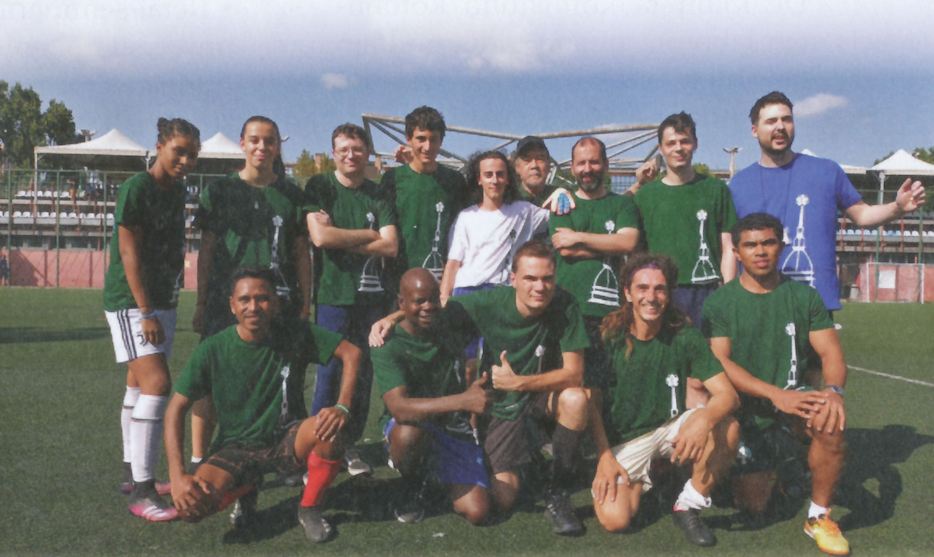
Contamination can also occur when a word is close in sound to one that is already offensive, and in that case the result can be the death of the theoretically innocent word. We can see this in terms associated with ethnic relations in America. For example, the English word “niggard” (probably originally brought to to England in the Viking invasions) means “miser,” but its closeness in sound to “the N word” (which was itself much less loaded a century ago than it is today) has driven “niggard” from use. Similarly, another Viking import, the rare adjective and noun “wight” meaning valorous or a valorous person, is too close to “white” for a race-conscious modern American to describe an admired hero as a “wight.”
Sometimes similarity of sound between words of opposite meaning can result in the selection of other terms to express the contrast. A non-spreading cancer is “benign” but a spreading-one is “malignant,” not “malign,” which would sound too similar. (A villain or evil conspiracy can be “malign,” but these days to call it “malignant” would imply it was spreading, cancer-like. The term “benignant” is now completely obsolete in all contexts.)
Zamenhof was certainly aware of these evolutionary processes, and it did not bother him to realize that if Esperanto became widely spoken they would be at work in Esperanto as well, although probably its very internationalism would constrain them to some extent. So far, at least, Esperanto examples are difficult to discover. One example, perhaps, is the emergence of liva “left,” replacing maldekstra in noisy traffic jams to avoid potential confusion with dekstra, “right.”)
Return to chapter list, top.
Problems of context and polysemy have been studied by anthropologists particularly in connection with religious ritual and with personality organization. Concern with polysemy is also central to much personality psychology and psychotherapy. Polysemy is the basis of psychoanalytic dream analysis, for example. Anthropologists primarily concerned with language normally attempt to set these problems aside, at least temporarily, and work with the primary meaning of each morpheme or word (to the extent that they are able to identify a single, primary meaning). Even the primary meaning of a given word in another language seldom corresponds perfectly with any word in English. People vary from culture to culture in the way in which they understand the world and in the way in which they therefore label and describe it.
One of the most vivid and famous instances of this is in the system of words that are used to name colors in different languages. Color terms proved to be a particularly profitable area of investigation because scientific measurements exist that can provide a continuous index of shade, hue, and intensity of colors. This means that the vocabulary of one language can be compared with that of another language by reference to absolute measures of light frequency.
Perhaps the most famous instance in anthropology comes from the work of H. Conklin among the Hanunóo of the northern Philippines:
Color distinctions in Hanunóo are made at two levels of contrast. The first, higher, more general level consists of an all-inclusive, coordinate, four-way classification which lies at the core of the color system. ... The second level, including several sublevels, consists of hundreds of specific color categories, many of which overlap and interdigitate. Terminologically, there is “unanimous agreement” … on the designations for the four Level I categories, but considerable lack of unanimity ... in the use of terms at Level II. (1955:341)
The terms at Level I could be very roughly translated as “black,” “white,” “red,” and “green.” However, they did not correspond very exactly with these English words:
“In general terms, [“black”] includes the range usually covered in English by black, violet, indigo, blue, dark green, dark gray, and deep shades of other colors and mixtures; [“white”], white and very light tints of other colors and mixtures; [“red”], maroon, red, orange, yellow, and mixtures in which these qualities are seen to predominate; [“green”], light green and mixtures of green, yellow, and light brown.” (1955:341-342)
Conklin points out that there are two distinctions in this, one between light and dark, the other between dryness or desiccation (red) and wetness or freshness (green), a division that makes particular sense in terms of plant life. “Green” is not a highly valued color, but
Clothing and ornament are valued in proportion to the sharpness of contrast between, and the intensity (lack of mixture, deep quality), of “black,” “red,” and “white.”
Level II terms were used only when greater clarity about color is specifically required. Conklin’s point in his article was to stress that even systems of color that were very different from those with which the analyst was familiar could be reduced to understandable propositions, and that, further, the ability or inability of people to perceive a color was independent of their tendency to name it. What his study showed also was the extent to which words for colors could vary between languages. It provided an excellent example of a color-term system based on entirely different principles from our own, one that reflected a very different way of understanding and labeling color. (One of the most useful general anthropological works on color terms to emerge from these studies was Berlin and Kay, 1969.)
Return to chapter list, top.
A common experience of anthropologists is that people generally have a well-developed terminology for describing what is important to them and a less well-developed terminology for describing what they are little concerned with. A speculative cocktail-party conversation early in the XXth century spawned the surprisingly widespread conviction that “Eskimos have a hundred words for snow.” That is not actually true, but it nicely encapsulates the principle of vocabulary expansion in culturally significant domains. (For an excursus about Eskimo words for snow, click here.) Here is a better example:
English speakers eat rice occasionally. Southern Chinese, however, eat rice much more often and are far more concerned with rice and its cultivation and preparation. An English speaker learning a southern Chinese dialect finds himself suddenly forced to select from a variety of different words every time he wants to say “rice” depending on the state of growth or preparation the rice that he is talking about is in. The accompanying diagram that we developed shows a method for selecting the correct word for “rice” from among nine different words used in southern Taiwan. No anthropologist would argue that this decision-tree represents the actual mental process that a Taiwanese speaker goes through, but rather that there is an order and logic to the semantic distinctions among the terms.
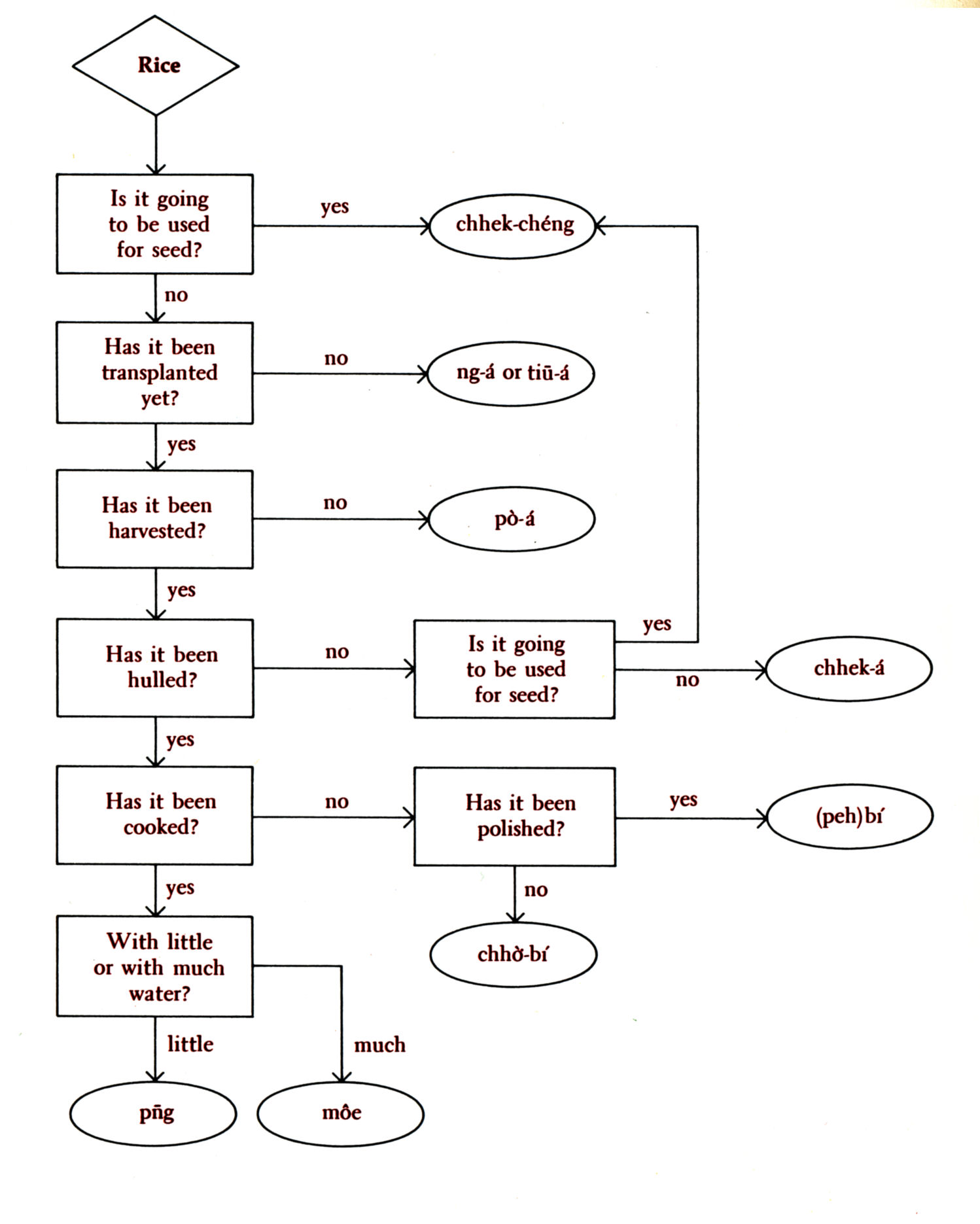
Return to chapter list, top.
Spinning off from studies of color terms, some anthropological investigation has focused on sets of words that name related but different concepts, such as kinship terms, names of different kinds of trees, names of diseases, and the like. The effort in “componential analysis” (definition) has been to identify the “components” of meaning that distinguish one word in the set from another. By way of example, let us consider the four words ē, ū, bē, and bô, in the following Taiwanese sentences, the same language that provided us the rice terms.
| i ū súi | She is pretty. |
| i bô súi | She is not pretty. |
| i ē bái | She is ugly |
| i bē bái | She is not ugly. |
| I bô tōa-hàn | He is not big. |
| i ē sè-hàn | He is small |
| i bē hn̄g | He is not far off. |
| i ū kīn | He is nearby. |
An examination of this and other similar sentences eventually shows that some kinds of adjectives are used with ū or bô and others with ē or bē. It seems that ū and bô are normally associated with adjectives meaning near, cheap, strong, fragrant, or pretty, while ē and bē are associated with adjectives meaning far, expensive, weak, stinky, or ugly. Further, ū and ē indicate the presence of the quality in question, while bô and bē indicate its absence.
We can detect two components of meaning running through the four words. One is the component of absence or presence, and the other is the component of desirability, which has two values: desirable and undesirable.
| Presence-Absence | Desirability | |
|---|---|---|
| Desirable | Undesirable | |
| Present | ū | ē |
| Absent | bô | bē |
Once we have clarified these relations we are able to understand the difference between the following two sentences:
1 I bô kín = He is not fast.
2 I bē kín = He is not fast.
The speaker of sentence 1 considers that being fast is a desirable quality, which, unfortunately, the person discussed lacks. Speaker 1 is saying: “It is unfortunate, but he is not fast.” The speaker of sentence 2, on the other hand, considers being fast to be an undesirable quality. Speaker 2 is saying: “Thank goodness, he is not fast.” Speaker 1 may be discussing an Olympic runner, while speaker 2 may be discussing a loose pig he is trying to catch.
Most componential analysis is done on sets of words distinguished by more than two components, however, and often the components that are discovered have more than two values each. In fact, in its heyday componential analysis was used almost entirely in the analysis of systems of terms used for kinship relations, a particular obsession of American anthropologists from the 1890s until the topic was dropped in the late 1980s —nearly a century later— through a plague of ennui with the topic. (Indeed, some advocates of componential analysis became so excited about their analyses as to call them “the new ethnography”!)
Zamenhof’s efforts to create kinship terms can give us a simple frame in which to see how componential analysis worked.
The words Zamenhof chose as kinship terms in Esperanto involve four components: lineality, generation, relationship through marriage, and sex. Of these, the first two can take any of several values, and the last one (sex), either of two (male and female). Naturally, therefore, the picture is more complicated than it was with the Taiwanese verbs we just mentioned. Zamenhof’s task was complicated by the fact that there is enormous cultural variation in how kinship is extended. In the end, he produced a set of terms that roughly corresponded with most European usage in the late XIXth century when he lived. Because the terms for females are formed regularly from the terms for males using the suffix -in, we shall omit females from our calculation for the time being. We shall also confine ourselves to “agnatic” (definition) relationships and ignore relationships through marriage (“affinal” relationships —definition), which are expressed in Esperanto exclusively through the prefix bo-. Let us begin, then, with a conventional diagram of Esperanto kinship terms:
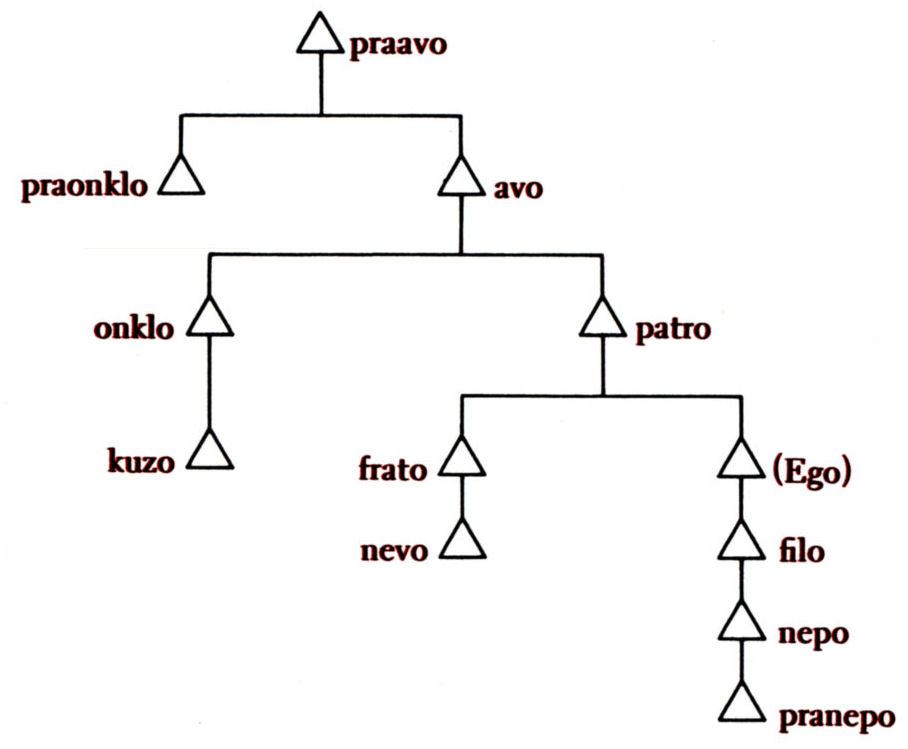
It is clear that one component of meaning underlying the differences between these terms is generation, ranging from the plus-three generation (pra-avo) to the minus-three generation (pra-nepo). the prefix pra- seems to mean “two generations away from Ego.”
It is also clear that generation alone will not explain the differences between all these terms, because in some generations there is more than one term. We therefore set up a component of “lineality.” A plus-one generation term that is “lineal” is patro.
The plus-one generation term onklo represents a kinsman who is not lineal, that is, not in Ego’s direct line of descent, and we can call this “collateral.”
In the zero generation, kuzo is a collateral term. Frato is also is in the zero generation, but, unlike kuzo, it includes all of Ego’s ancestors (though none of his descendants), a relationship anthropologists call collineal. If we wish to diagram these words in terms of these two components of lineality and generation plus sex, we end up with a diagram like the following:
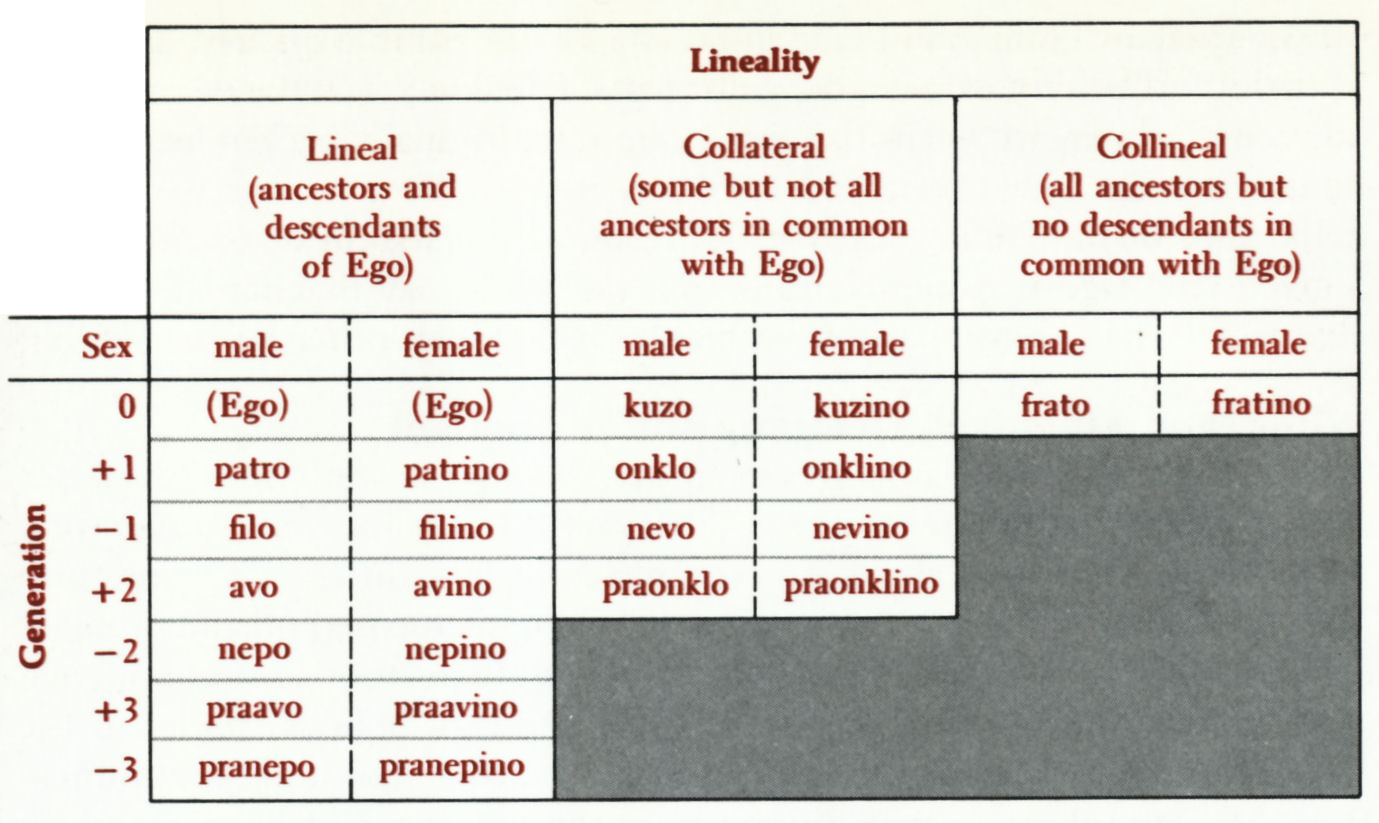
The component of sex could have been omitted here just as it was in our more traditional kinship diagram because all of the relations can be traced through any combination of male and female links, and the term used when the individual referred to is female differs from the male term in a completely regular way. Obviously such regularity exists by design; most natural systems are not so tidy. (For example it is not unusual to trace descent lines through males only or females only, so Ego’s mother’s mother is called by a different term from Ego’s father’s mother.) But what was poor Zamenhof to do? After all, he wanted to keep things simple.
Zamenhof also used another element, the prefix bo- (from French beau-, “-in-law”), in his kinship terms to represent relations through marriage. Like the English phrase “-in-law,” it is used to form names both for Ego’s spouse’s kinsmen and for kinsmen’s spouses. At first blush, these forms are much simpler than in many languages, and the components are not difficult to understand once we isolate them, but modifying our diagram to include forms in bo- would make it seem far more complex than it is. Not surprisingly, unnecessarily complex data displays easily draw criticism. (A substantially more complex set of words for kinship relationships is included in an article on Chinese mourning categories elsewhere on this web site —link.)
Return to chapter list, top.
Analysis of a set of terms according to the components of meaning that underlie their contrasts is a very powerful tool for understanding some systems of terms. It has been conspicuously successful with kinship terminologies in particular. It is less useful when the number of components is very great compared with the number of terms. The example of words for rice mentioned earlier would be clumsily handled by componential analysis because of the large number of components (hulling, cooking, transplanting, etc.) involved.
Componential analysis also has difficulty dealing with polysemy, the father-kinsman and father-priest problem. Thus, different “components” are called into play in such pairs as “man/animal,” “man/woman,” “man/boy,” “man/sissy,” which are dependent upon the polysemy of the word “man.”
Similarly, relations of inclusion are difficult to handle componentially: in the United States the republic includes states, states include counties, counties include townships and cities, and cities include wards.
Whether by componential analysis or in some other way, the advantage of including a body of related words in a single analysis is that it improves our sense of exactly what a word refers to by making clear where the boundaries are between it and some other word. It gives one a sense, as definitions of individual words seldom can, of the system of meaning that a given language is using in examining the world. By making this system explicit, it enables comparison with other systems in other languages.
(Elsewhere on this web site a brief essay approaches some of these problems by differentiating center-focused from boundary focused definitions. Link.)
Return to top.
Go to chapter list,
preceding,
next chapter.